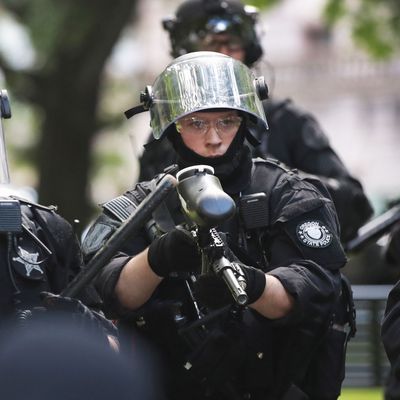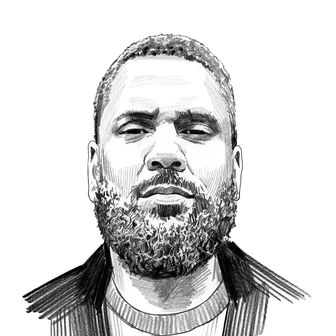
President Trump sent federal agents to Portland, Oregon, to stoke conflict ahead of the election, but their deployment also redirected outrage that was previously aimed at local police. This was a reprieve for Portland officials who viewed the president as an antagonist they and the protesters could both agree on. Now that Trump’s troops are scaling back, these officials have to contend with, yet again, how the city’s most persistent policing excesses have always been homegrown. Their behavior in the days since has only reaffirmed it.
On Saturday night, officers with the Portland Police Bureau slashed the tires of a local journalist’s Toyota Prius and shattered its back window while the driver was trying to leave a protest. The assault came amid an escalation of police violence; officers chased demonstrators away from a local precinct, pepper-sprayed them, and knocked them to the ground while making several arrests. The three nights prior had been relatively calm. In early July, the president had deployed militarized forces to Portland from a range of federal agencies — the Federal Protective Service, Immigration and Customs Enforcement, Customs and Border Protection — weeks after telling state governors to “dominate” the dissidents and rioters who’d taken to the streets after George Floyd’s death; if they couldn’t do it, Trump said, he would send in the military. As if to underline his point, the president had protesters in Washington, D.C.’s Lafayette Square teargassed and beaten so he could walk to a nearby church for a photo op that same day.
The following weeks saw his approval ratings plummet. Yet even as tensions eased between police and protesters in Portland, Trump saw hope for his reelection campaign in reviving them and casting himself as subjugator. In fact, his belated adventure had the opposite effect. Images of his agents in fatigues shooting protesters with “less lethal” munitions, blasting them with chemical irritants, snatching them off the streets and throwing them into unmarked vans — all caused the demonstrations not only to grow in size but to spread to other cities. Portland mayor Ted Wheeler was among those teargassed by federal agents during the unrest. “This is abhorrent,” he told the Washington Post. “This is beneath us.” By the time the White House and Oregon governor Kate Brown had negotiated an agreement to reduce the agents’ presence, prompting some of them to withdraw, local police and protesters were back in a holding pattern of regular clashes.
It was a fitting resolution to Trump’s tenure as the villain of the Portland demonstrations. In a way, it mirrored his rise to power — an escalation, but temporary and stemming from a preexisting crisis that will outlast him. The crisis here is painfully familiar to many Portlanders on its receiving end, a disproportionate share of them Black: a police force with a history of abuse, led today by a mayor who is unwilling — or unable — to fully rein it in. “It is a power struggle to maintain whiteness and white supremacy that dictates the policy here,” local activist Teressa Raiford, who is Black, recently told Rolling Stone. Her insight is long held: In 1981, Portland police “pranked” Raiford’s grandparents by tossing four dead opossums in front of their soul-food restaurant. The act was an especially crude manifestation of prejudices the police had displayed for many years and gotten away with. (None of the officers involved in the opossum incident lost their jobs, let alone faced legal consequences.) These were best documented starting in the middle of the last century: During the 1960s and 1970s, Portland police targeted Black Panther Party members for harassment and violence with a zeal comparable to any West Coast police force at the time. In 1985, officers killed a Black former Marine named Lloyd “Tony” Stevenson by putting him in a choke hold; some greeted the ensuing outcry by selling T-shirts from a precinct parking lot that read “Don’t Choke ’Em, Smoke ’Em.”
The violence has not abated with the new century. From Rolling Stone:
In 2003, 21-year-old Kendra James was gunned down during a traffic stop; in 2010, 25-year-old Aaron Campbell was killed by a sharpshooter during a welfare check; in 2017, police shot 17-year-old Quanice Hayes with an AR-15 while he was on his knees during an arrest. None of these cases were prosecuted.
Even when Portland police have not engaged in physical violence, they’ve more than compensated by eroding public trust in other ways. In 2014, Captain Mark Kruger, who led the Bureau’s Drugs and Vice Division, was commended by the Bureau and had multiple items on his disciplinary record expunged as part of a legal settlement. At issue was what his attorneys called “slander” at the hands of superior officers who called Kruger a “Nazi” in a series of text messages. Their reason? Kruger had nailed memorial plaques for five Nazi soldiers to a tree in a public park.
Portland’s police have accrued more public antipathy since, and with fair reason. The recent protests in Portland have been defined by the police’s failure to differentiate between the handful of people rioting and throwing projectiles at them and the overwhelmingly nonviolent majority. Officers have beaten dissidents and carpeted entire sections of the city in tear gas. Mayor Wheeler — who also serves as Portland’s police commissioner — has refused to ban its use. “I would support the discontinuation of tear gas provided that there are viable alternatives for dispersal that do not involve higher uses of force,” he said last month. “I’m not willing to say today I would ban it.” Meanwhile, the police have exhibited a striking degree of militarization; before Wheeler directed them to stop, officers were using a military-grade Long Range Acoustic Device (LRAD) to disperse demonstrators. The device was developed to send ear-damaging sonic blasts from Navy ships to dispel attacks from other vessels. Over the past two decades, it has been used with growing frequency against civilians by local police departments.
This conduct predates Trump’s incursion. It’s still happening now that he’s withdrawing. The history in which it’s rooted has little to do with federal meddling in local matters. It’s a homegrown phenomenon, kept afloat by local administrators who are, nevertheless, quick to cast Trump as the greater law-enforcement threat. But as the president dispatches his agents to other cities, Portland’s reality will prove to have national salience. His authoritarian theatrics are a menace. The greater menace is usually closer to home and harder to escape.






























